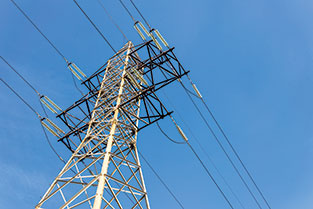
Composites Increase Power Line Capacity
Overhead conductors used to transmit electricity typically consist of stranded aluminum wires that surround a stranded steel wire core.
However, a more recently developed conductor consists of composite materials of carbon and glass fibers that replace the stranded steel supporting member. This new type of conductor will be covered in a recently-approved ASTM International standard, B987, Specification for Carbon Fiber Composite Core/Thermoset Matrix (CFCC/TS) for Use in Overhead Electrical Conductors.
B987 will establish the methods used to measure critical properties of composite core products specifically for overhead power line applications. These properties allow a composite conductor to perform at much higher power levels than a traditional steel-core conductor.
"When steel is replaced with a composite core, the conductor becomes much stronger and lighter, and has less expansion with increasing heat," says ASTM member Eric Bosze, manager, application engineering, CTC Global. "This allows these new conductors to carry as much as twice the power as a standard conductor of the same size."
Bosze notes that utilities will use B987 to ensure that the composite conductors they purchase will perform according to their line designs. "This will further ensure that the overhead conductors are capable of the application and that they will safely perform as needed," says Bosze. "Manufacturers will use B987 to ensure the composite core products they use in their cables are in compliance with industry standards."
Outside testing agencies that support utilities and manufacturers will benefit from B987, since it will allow these agencies to consistently measure the properties that determine if the composite core or conductor is acceptable for a given application.
"Overhead power lines bring in electricity from far away locations into cities and factories, where the power is needed for practically every use," says Bosze. "When the capacity of the lines can be increased, the likelihood of blackouts or brownouts is greatly reduced, and this helps to ensure that everyone gets the electricity they need with the highest degree of reliability and efficiency."
B987 was developed by Subcommittee B01.07 on Conductors of Light Metals, part of ASTM International Committee B01 on Electrical Conductors. All interested parties are invited to join in the standards developing activities of B01.
CONTACT Technical Information: Eric Bosze, Ph.D., CTC Global • Irvine, Calif. • Phone: 949-381-7262 | ASTM Staff: Kristy Straiton • Phone: 610-832-9640 | Upcoming Meeting: April 29, 2015 • April Committee Week • Anaheim, Calif.
 SN Home
SN Home Archive
Archive Advertisers
Advertisers Masthead
Masthead RateCard
RateCard Subscribe
Subscribe Email Editor
Email Editor